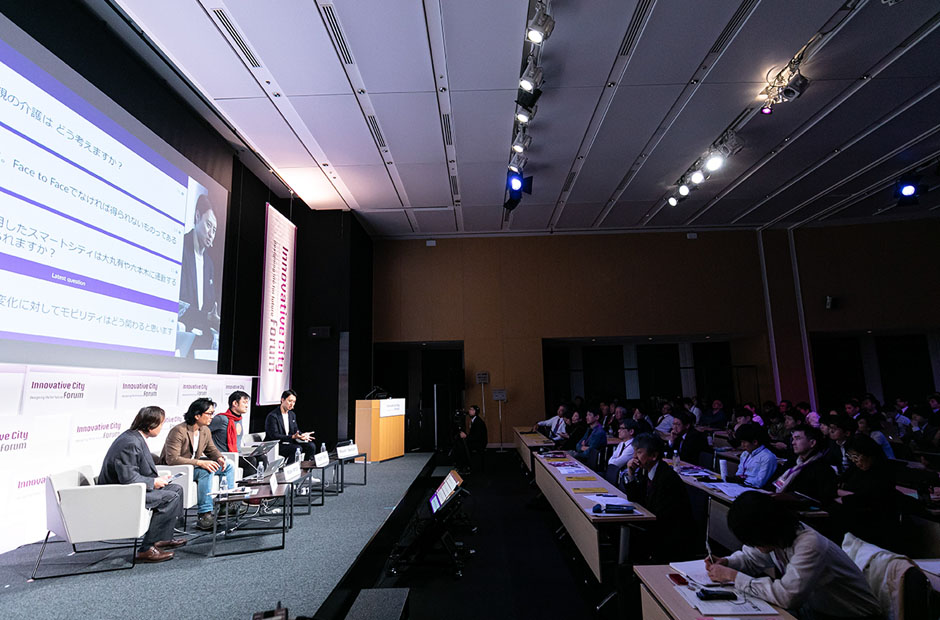Tokyo 2035 - Radiant World City:
What Will People Want from the Urban Spaces of the Future?
Roppongi Academyhills Towerhall
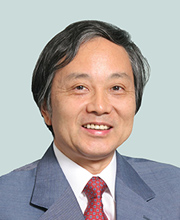
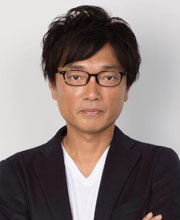
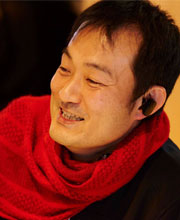

Supervisor of Sales and Marketing,
WeWork Japan
Introduction
Ichikawa
At the Mori Memorial Foundation’s Institute for Urban Strategies, a research study was conducted on how the evolution of technology and changes in values will alter the lifestyle of the city of the future, and this was expressed in an animated film in 2017. In contemplation of the future city, we focused on four urban functions: Future Living (food, clothing and housing), Future Work (how to work), Future Entertainment, and Future Mobility. However, in recent years, the boundaries of urban functions have become blurred. Today, I would like to discuss the impact of such trends on the urban spaces of the future. At the beginning of the session, I would like to ask the audience to respond to a simple questionnaire on “lifestyle and working style.”
Question 1 to the audience:
“What is the relationship between
‘work,’ ’reside,’ and ‘play’ in your ideal lifestyle?”
| Choices | % |
|---|---|
| I want a clear distinction between ‘work,’ ‘reside,’ and ‘play’. | 25% |
| It’s acceptable for ‘work’, ‘reside,’ and ‘play’ to be mixed. | 69% |
| I don’t really think about it. | 6% |
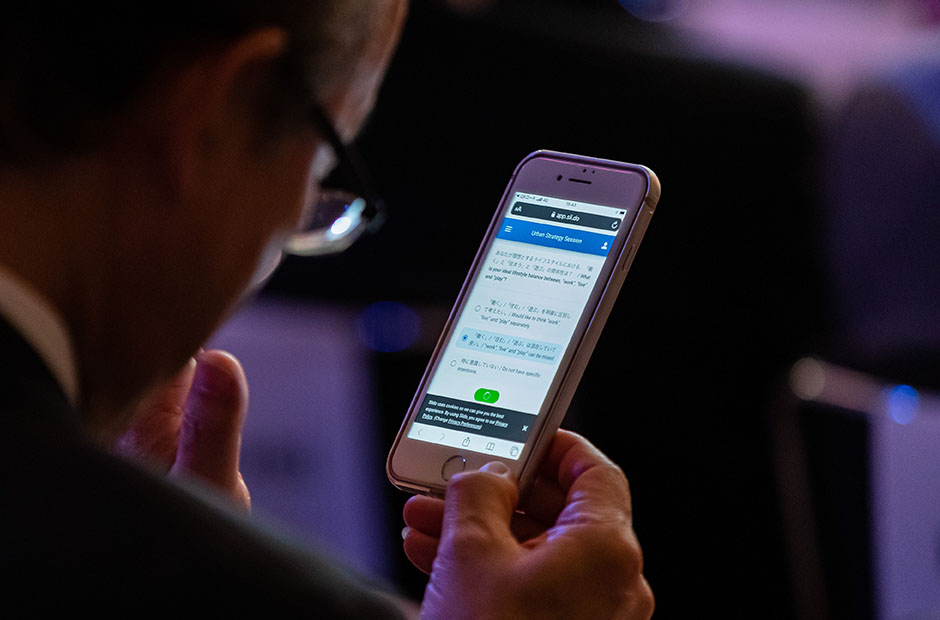
Question 2 to the audience:
“When you think about your future, where are you working?”
| Choices | % |
|---|---|
| I mostly work from home. (Home office type) | 10% |
| I mostly work in an office. (Conventional type) | 24% |
| I have a place to work in at my own pace in addition to my office. (Satellite type) | 73% |
| I don’t have a permanent office and change work location depending on the situation. (Mobile type) | 29% |
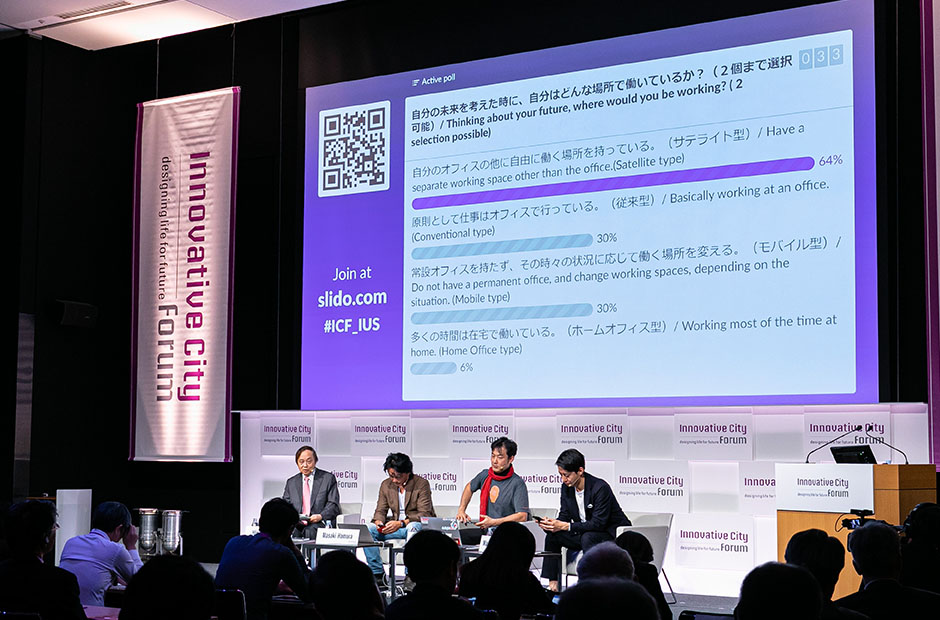
Looking at the results of the questionnaire, we can see that almost 70 percent of the respondents believe that ‘work,’ ‘reside,’ and ‘play’ can be mixed. Looking further shows us that regarding the future style of working, although telecommuting has recently made it possible to work from home, many people express a preference for the satellite type as opposed to the home office type. With these results in mind, I would like to proceed with today's session.
Presentation
Masaki Hamura “Cities 5.0, Towards the era of the ‘city of individuals’”
In his book “Urban Design,” the late Kisho Kurakawa advocates that cities have undergone five transitions so far – “The city of gods,” “the city of kings,” “the city of merchants,” “the city of corporations,” and “the city of individuals.”
“The city of gods” saw trade and record keeping, as well as credit exchanges for trade being implemented. The driving innovations of this era were the concepts of accounting and writing, and these new technologies made it possible to keep accurate records. This allowed for an era of expansive trading and in turn the establishing of cities. In this age, gods were consecrated and worshipped in temples and shrines, and the configuration of the city was divided around these places of worship with other structures around them.
Following this, temples and shrines became connected with the people in power and the king emerged, resulting in “the city of kings.” The innovations of this era were money, an alphabet, the codex and the expansion of “information.” Money existed as evidence of credit transactions, and the alphabet arose as a way of broadening knowledge. In addition, the creation of the codex, a precursor to the modern book, made information easier to store and carry. This led to a rapid spread of information, and an expansion in area. In this era, the city was surrounded by walls and centered on the king’s palace. Inside the walls, a class of citizens called the bourgeoisie, as opposed to the king, emerged. As a result, the square (Agora) was formed, which was a public space for the citizens.
Subsequently, in “the city of merchants,” letterpress printing was born. This allowed information to be copied and spread throughout the world, resulting in the development of industry and commerce with economic growth and democracy blooming through trade. In other words, technology has transformed the social structure, changed the nature of economy, and modified the lives of citizens.
It was not until the age of the “the city of corporations” that energy and mobility technologies revolutionized the city. The Industrial Revolution led to an innovation of three things combined: “energy”, “mobility”, and “information.” The urban spaces of this era were composed mainly of roads and high-rise buildings, which led to an increase in efficiency. The former walls were removed leading to sprawl, and as a result of various elements within the city mixing, and pollution and problems arising, the concept of urban planning was born, dividing cities into different areas of use. In other words, in pursuit of economic rationality, architecture was mechanized and cities were designed around mobility.
Having experienced different stages in the past, what we are about to see in the future is “the city of individuals,” namely “the age of a cyber and physical fusion.” This is becoming an era in which “mobility” and “energy” will be driven by “information” at the heart of everything. By putting a computer in every person's pocket, we were able to connect to the world. During the Great East Japan Earthquake on March 11, 2011, Japanese tweets spread globally. The age when such power became available to us was already evident a decade ago. Previously, this power had only been on a personal level, but now it has reached objects and expanded to the IoT (Internet of Things).
In the digital transformation debate, “Data analytics” is often talked about as a way of collecting data, analyzing it, and providing some kind of service. However, there is little debate on actually operating it, making it sustainable, and how it will be engaged with humans. “Human-centred” and “human-centric” come up as general themes, but the essential story hasn’t been discussed. This is what I’d like to present as an issue.
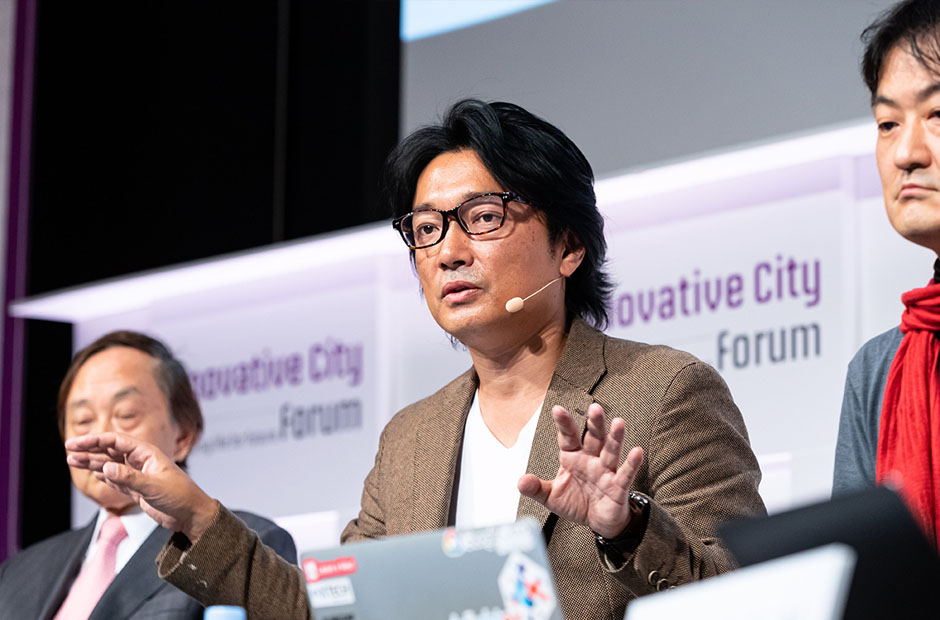
Kazuhiro Obara “An era of working with anyone, anywhere”
Currently in my thirteenth job, I’ve been involved in forty-two projects so far. My living and working lives are fluid, and while that usually means people don’t know where I am, my home bases are Bali and Singapore. In Bali, I work in the playground of my daughter’s school. My home in Bali has two-bedrooms, a private pool and is cleaned three times a week by a maid. It provides good access and the center of Ubud can easily be reached in about five minutes on foot, but the rent is only JPY100,000 yen per month. Using an LCC (discount airline) you can make a round trip between Bali and Japan for about JPY30,000, so even if you come to Tokyo once a month, it’s possible to live on JPY140,000 to JPY150,000 a month. Under these circumstances, why do so many people make the choice to live in cities? If living in a city isn’t a necessity, I believe it’d be better to live by hopping around places that provide you with inspiration.
The essential element of being real, not only existing online, is that people meet and new connections are made. These new meetings and connections are defined by Schumpeter as new bonds, and if new bonds mean connecting distant things then it follows that it is better to go far in order to innovate. Up until now, where you worked and learned were always tethered to where you lived. However, the internet has now made it possible to work remotely, allowing the freedom to live and work wherever you choose.
But more importantly, children's learning is also affected by the place where they live. This is also changing, however. My daughter's school is a three-story bamboo-lined school with no walls called Green School. Here four hundred children from forty countries around the world, from kindergarten through to high school, gather to study on a project basis. Thanks to the internet it’s possible to learn even in a place like Bali. If your only purpose is to memorize, then just study at home using YouTube, which has a lot of interesting teachers. At school, based on what they have learned, students have discussions on how to protect Bali’s pristine nature and how to attract more tourists. That is definitely more human.
Technology humanizes the impersonal, and society is now heading in that direction. It was four years ago that I shifted to my current lifestyle, but at that time the population of Facebook was just over 1.5 billion people. That number is now more than 2.3 billion people. In other words, the biggest country in the world is actually the country of Facebook. And if you live in the country of Facebook, your physical location becomes irrelevant.
The internet is about eliminating distortions, and by connecting everything without friction it draws out more humanity. Jack Dorsey, the founder and CEO of Twitter is now also in the payments business with the belief that it is important to bring out communication such as “We have some good coffee today” when paying at a store because people are face-to-face with each other at the cash register. I believe this is how technology and the internet ought to be. With such a melting of boundaries I’d like to discuss today what kind of city we’d like to live in and how we want to move from one place to another.
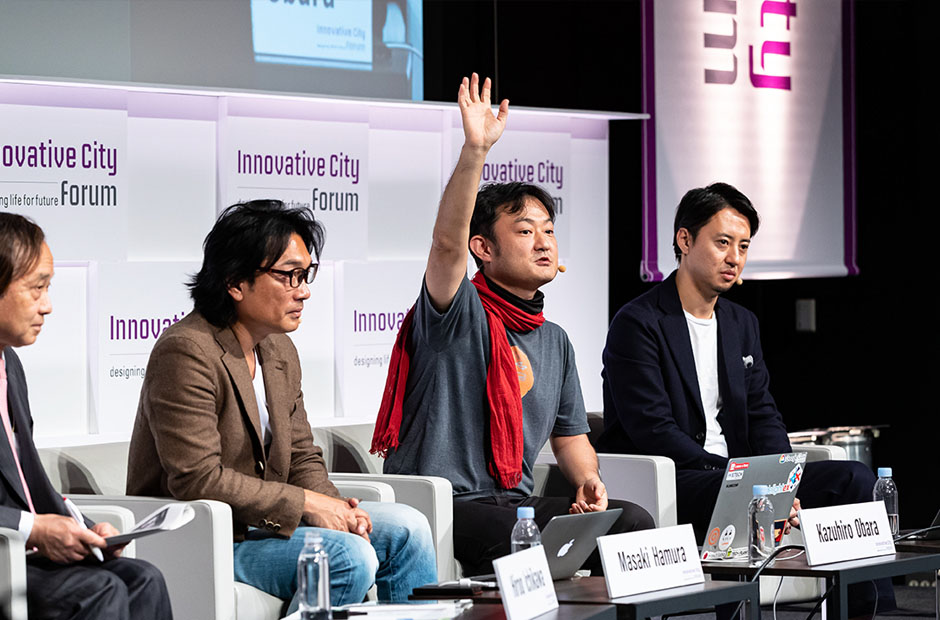
Masami Takahashi “How to work in the future from the viewpoint of a community workspace’
I became interested in how we can transform the way we work through our environment and what kind of meaning we can give to our work, and I’ve been at WeWork for about two years now. WeWork was founded in 2010 and operates community-based workspaces around the world. The key word "community" is essential, and as technology and AI evolve in the future, we are finding value and potential in the connections made between people.
There are four main businesses.
The first is space (workspace) and currently there are about six hundred locations worldwide. We are creating open workspaces full of natural light.
The second is community. With various companies, organizations, and municipalities converging in the same place, we provide a community in which we try to draw together companies and individuals who are not usually connected and have them create new values.
The third is service. When working, in addition to actual work, there are a number of things you have to take into consideration, such as office operations or moving. Therefore, WeWork also undertakes other services so that you can focus on your core business and priorities.
The fourth is technology. With now nearly six hundred thousand members at six hundred locations around the world we utilize technology to provide a platform for connecting those members.
We refer to the above four as "open innovation platforms” and provide space so that companies that would not usually collaborate, or two individuals who would not usually have the opportunity to meet do just that, and start something interesting.
In Japan in February 2018, we opened a base in Roppongi 1-chome and have been operating for about two years. In addition to a global context, our mission is to promote work-style reforms in Japan, and to connect enterprises from startups to large companies.
Currently, we have twenty-three offices open in Japan, and in addition to Tokyo, the company operates in five other cities (Fukuoka, Kobe, Osaka, Nagoya, and Yokohama). In Japan, venture companies with just a few employees, large companies, and municipalities use WeWork. We conduct an annual survey of our members regarding how they feel about using our service, and one very prominent result in Japan is that more than 80 percent of members say they have realized business growth by joining WeWork. They have stated that by moving into our space there were changes and impacts that did not occur in the past.
According to the research firm Gallup, when asking 139 countries “How rewarding is your work and how enthusiastic are you about it?” Japan ranked 132nd, with only 6 percent feeling passionate about their work. But despite this, thinking optimistically, Japan is still an economic powerhouse. If people gain motivation and have pride and enthusiasm for their work from here on, there will be the opportunity for even greater output.
The theme of the future of work is "collaboration." A joint study with Ipsos shows that people value connecting with, talking with and meeting people in their careers and workplaces. We believe that improving the working environment will improve the satisfaction and motivation of workers and ultimately increase productivity, and we hope that we can support this.

Panel Discussion
Q:“How will people engage with technology, data, and A.I. beyond simply using them?”
Ichikawa
I agree that it is important to discuss how people engage with data and technology. Irrespective of how technology or the world changes, we have to be happy and motivated in order to progress.
Hamura
Both Amazon Go and Lawson's cashierless stores utilize technology, but Amazon Go is more focused on improving things for people. Amazon Go has revolutionized the way we think about shopping. Lawson is introducing technology that allows customers to make their own payments to reduce costs, while Amazon Go is using technology in order to enhance person-to-person interaction through their shopping experience. That kind of thinking is very important.
Lawson**
:a convenience store franchise chain in Japan
Q:“The mechanism and know-how of creating collaborations”
Takahashi
Some people ask, "Is it true that collaboration emerges between shy Japanese people who don’t know each other?” At WeWork, coffee and beer are free. When you hold a drink in your hand, communication may arise that differs from that of the usual workplace. Such a space hadn’t existed in the workplace before, and there was no pressing requirement for self-expression. More precisely, it was considered taboo. However, in such an open atmosphere, we provide an environment where you can express yourself as an individual.
Obara
How to create an environment that encourages innovation is important. Google conducts research through Project Aristotle in which they try to reveal how people work creatively. One example is the micro-kitchen, which creates a space where you can drink coffee and eat snacks at the hub of each office, to design a "casual collision." It is about trying to create new bonds by making a few unusual contacts in everyday life.
However, the most important factor driving innovation and creativity is "psychological safety." Innovation is about doing things that have never been done before, and it is important that you are able to take risks with your peers. It is also critical to create a community culture where you can express yourself without hesitation, knowing that no matter what you say, you will not be ridiculed.
Takahashi
It's exactly that sense of security which is so important, and people with no prior contact up until now can find common ground by belonging to the community provided by the WeWork platform. With that common ground, they will be able to overcome psychological hurdles and create new conversations by being in the same physical space, attending the same events, and drinking coffee or beer in the same way.
Project Aristotle**
:Google conducted research in order to clarify the characteristics of the effective teams within Google, summing up Aristotle's words "the whole is better than the sum of its parts." The research was conducted to find the answer to the question "what conditions enable effective teams?"
Psychological safety**
:how an individual perceives the consequences of taking risks in an interpersonal relationship, meaning whether they believe that " actions that may be perceived as ignorant, incompetent, negative, or intrusive will be tolerated in this team.” Members of a team with a high level of psychological safety do not feel insecure about taking risks with other members, and there is room for the belief that no one will ridicule or punish them, even if they admit their mistakes, ask questions or present new ideas.
Q: “Why does Silicon Valley still attract people in an age when you can work anywhere?”
Obara
Based on statistical results, IBM does not recommend remote work as it is deemed inefficient. As at Google, face-to-face is considered more efficient when the small team is focused like a shotgun and needs to produce a result in a short period of time. Silicon Valley is a place where a shotgun-like output happens like a chain reaction. Y Combinator, the world's largest seed accelerator program, requires companies to be within 2km of their office once they have applied and been accepted. That's because as soon as you receive a call saying, “I’d like you to meet a key person,” you'll meet them right there and something new might emerge. Density is essential if you really want to create something new in a short period of time.
Hamura
Face-to-face is fundamentally important. After all, ideas and complex developments are born in the fusion of people. Giving the example of Japan in the past, there were a lot of products for which the ideas and plans came out of the smoking room. The key is to create that kind of situation as a mechanism. A city is primarily such a thing and Silicon Valley is such a place.
Obara
I think cities are like hashtags. People who do Instagram or so on have their favorite “# (hash tag)”. In a way, WeWork is a “#” with very edgy workers, and Silicon Valley is a “#” for IT people.
Q:"What will happen to Tokyo's metropolitan area in an era where people can live and work fluidly?"
Obara
I think it is the same as I mentioned earlier, and I think it is about what kind of “#” to have. For example, in Portland, USA, which is famous for its urban rebranding, they decided to make the city's mission statement a "#": "people who want to live in balance between the city and nature ." When you decide on a "#", the city itself will become like WeWork, because people who align with your values will converge. I now think it’s about what kind of “#” Tokyo wants to have.
Hamura
In the world of urban planning, people used to be seen in terms of daytime population and nighttime population, but these are not the only two types in cities. There are people who travel around the world on business, like Mr. Obara, and there are also tourists. However, because people are physical beings, they need somewhere to sleep. The future of the city is all about whether it can draw people to stay and sleep there, not only about increasing the daytime and nighttime population.
Obara
Despite the rise of the internet and the possibility to listen to music anytime, anywhere, the market for concerts and live events in Japan has doubled over the last decade. Because information can be connected and shared anywhere, people actually gather for real things that can only be experienced at that time. Furthermore, you want to go to a place where you can have a genuine experience that you can brag about.
Q:“Perspectives and attitudes necessary for the ongoing large-scale development in Tokyo”
Ichikawa
In Tokyo, large-scale urban development is taking place everywhere, but from your point of view, I would like to hear your opinion on what urban development should be and what should be done.
Hamura
As previously mentioned, the “#” is very important. In short, why and what, which decide how “#” is attached to “#Ebisu” or “#Shimokita”, exist in the context of a city. I think that urban development should keep in mind the thoughts of the people gathering there and the historical accumulation of the area.
Obara
When it comes to a hundred years of life, Linda Gratton believes that three things are necessary. The first is how to improve productivity and oneself in an environment in which a large number of people are becoming professionals. The second is, how you can continue to transform yourself in circumstances where innovations emerge in quick succession and are soon commoditized. The third is vitality, which becomes the foundation of a person, that allows you to continue doing the two mentioned above. When I think of these three assets: productivity, transformation, and vitality, I think it's important to consider what kind of asset you want to see rooted in a city. Silicon Valley is a city of “transformational asset.” For me, Ubud is a city of “vitality.” It is more compelling to dig deeper into what assets a city provides and what the “#” is based on.
Linda Gratton**
: author of “The 100-Year Life: Living and Working in an Age of Longevity.”
Q:“How can the extra free time be used?”
Ichikawa
As remote work begins, free time and leisure time increase. When asked how you would spend that time, would you answer in nature, in the city or by the sea?
Hamura
For me it’s nature. But depending on my mood I may go to a museum or watch a movie. Basically though, there isn’t much concept of leisure for me.
Obara
I’m not too fond of the word “leisure” in Japanese. If written in kanji you write “there is too much free time.” In English you simply say “leisure.” The original etymology of leisure means “freedom.” In essence leisure isn’t something you have to do out of obligation, but rather means you have an option of doing something freely. And as for the phrase work-life balance, I believe it is life-work balance. In other words, it’s about how much you can increase the proportion of your life-work in your life. If my life-work is 100 percent then I want to be working all the time, and of course I want to cherish the time I spend with my family as well.
Q:“What will happen to the many office buildings being used now if work styles change?”
Takahashi
I think their value as a container will change. For example, people are moving away from owning and driving a car to something like UBER where you share the service. It is becoming important to have the plans and values that make you want to go to a place or an office.
Obara
It’s good if there is a reason to get together. My friend’s company is very unique. They tell you to do your own work at home but that it is better to come to the office when you have your lunch because that increases intimacy among workers. In addition, they tell you to come to the office when you are doing a side job because you can show others a skill of yours that you don’t usually use and you can consult someone when you’re in trouble. I believe you can redesign values for people to gather in any way.
Hamura
We need to be competitive as a city, we need to think about what the “#” of each city is, but first we need to increase the variety of people, not just the daytime and nighttime populations. As for myself, I work at a satellite, but if an individual has multiple bases, then 1 x 5 locations = 5 working spaces are created. As the number of people working in this way increases, the types of people in the city and the number of locations per capita also change. In addition, the workplace will not be a single-use office, but mixed-use like WeWork. We can easily solve the problem of having too much floor space, and this is probably the direction in which cities are heading.
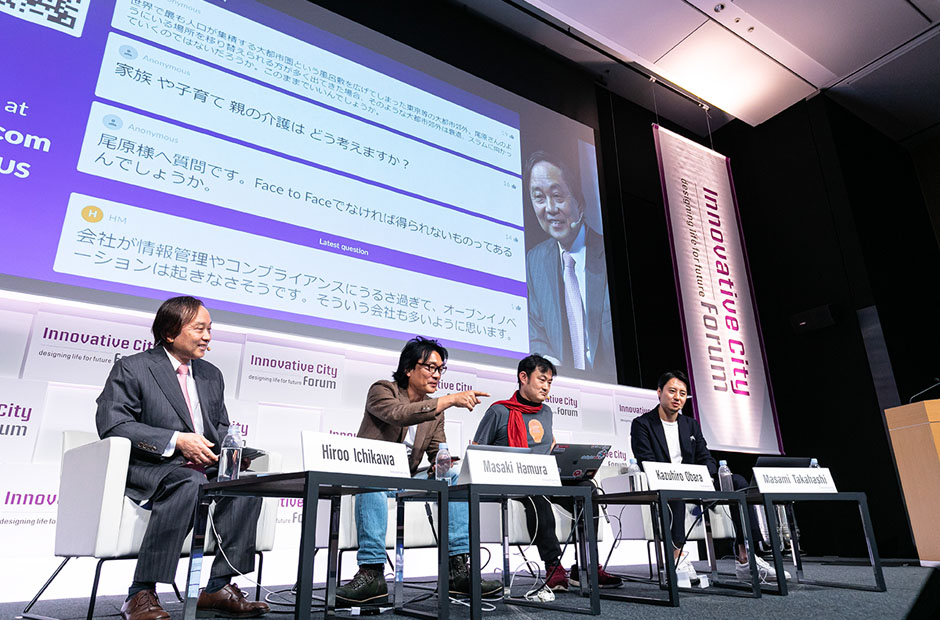
Q:“What do you hope for the future of Tokyo’s urban space?”
Ichikawa
What do the speakers want to see in Tokyo’s future urban space?
Hamura
With all the implications of the community, encounters and what emerges there, I think that “cities will become WeWork.” In other words, “members” of WeWork and “citizens of Tokyo” will have the same meaning. This means that a city will become the core of a community and networks will be connected from there.
Obara
I think that Tokyo’s most distinctive and admirable features are that it holds the highest number of Michelin stars in the world and it is the city of cute and edgy culture “#.” I believe it is important to reconsider the roots of the city and for me Tokyo’s identity is still that of an “edgy culture.”
Takahashi
It is quite common for me to return from overseas and notice the positives of Japan, and I think it is important to have a lot of foreign people come to Japan to discern those good points. People from abroad say that the vending machines and other things in Japan are amazing, and for the first time we realize, “Oh, that’s right” and “They are better than overseas. With numerous influences from overseas and places where new perspectives converge, I think that people in Tokyo will be able to realize the excellence of Tokyo and turn it into positive energy. I hope that it becomes "a place where the identity becomes appealing and attracts people from abroad." I want it to be a place that makes people want to work here, not just visit as tourists.
Question 3 to the audience.
“Choose the keywords you agree with” (multiple answers allowed)
※Audience approval rating for each keyword
| Speakers | Keyword | Approval rating(%) |
|---|---|---|
| Masaki Hamura | “The city itself becomes WeWork (community)” | 50% |
| Kazuhiro Obara | “A city with an edgy culture” | 47% |
| Masami Takahashi | “A place that attracts people from overseas” | 50% |
| Hiroo Ichikawa | “A city where you can feel the heart of the people” | 42% |
Q: “What will Tokyo be like in 2035?”
Ichikawa
The point in time for today's discussion is set in 2035. It's not a too distant future, only 15 years from now, but just beyond the near future. How will Tokyo change over the next 15 years? I would like you to talk about the Tokyo you envision, its appeal and the challenges facing the city, if there are any.
Obara
Over the period of time to 2035, probably the most prominent is the evolution of simultaneous speech interpretation using AI. With some kind of device in our ear, the time when we can talk with people from any country without any friction, at the same time that the conversation is being carried on, will most likely be around 2035. VR / XR will also be cheaper and more wearable, like glasses. In other words, I think eyes (sight) and ears (hearing) will be borderless. What remain are the tongue (taste), nose (smell) and skin (touch), and in this regard Japan may hold an advantage as it is quite a gastronomic nation.
Hamura
The most significant is the evolution of the information part of the brain. Fifteen years ago, in 2004, we were using Galapagos phones and i-mode , which were precursors to the smartphone. With that in mind future UI will probably be very different from now. Under the circumstances where AI is running in the background, providing less friction and allowing any kind of communication, we will be able to communicate like we’re using “honyaku konnayaku” (translation jelly). With this, the weakness of low English proficiency in Japan will disappear.
Takahashi
I also believe that the next fifteen years will be the time for AI to evolve significantly. As verbal borders decrease, I think that the art world will remain as a non-verbal communication tool. A new common language called art will become more important for communication between people. Currently, there aren't many people who would assert that Tokyo's hashtags are art, but I do think digital things and art will become a feature of Tokyo's identity in the future.
Galapagos phones**
: The old style Japanese phones which are now referred to as "garakei"—a compound word from Galapagos and "keitai denwa" aka mobile phone. They were dubbed Galapagos phones because of how comparable they were to life on the isolated Galapagos Islands. Like garakei in Japan, the animals and the flora on the Galapagos were unique to the island and couldn’t be found anywhere else.
imode**
: a mobile internet browsing service which was released in 1999 by NTT Docomo, a Japanese telecommunication giant company.
“honyaku konnayaku”
: a future tool which appeared in a famouse Japanese animation show "Doraemon". It anables the person who eats it understand and even speak multiple languages.
Q:“How will people feel happiness in the future of 2035?”
Obara
We now live in an age in which we must decide our own future. I think that is a happy thing. I define "freedom" as “finding reason in oneself for doing something.” I'm free and happy right now, because my reasons for wanting to make everyone smile through the power of technology match my current state. Just as there is a city “#”, isn’t it important that you think about what your own “#” is?
Hamura
The history of the human race is the history of attaining freedom, and technology has advanced to that end. However, when that freedom is suddenly acquired and you find yourself presented with a multitude of options, it may conversely feel inconvenient. At such a time, it becomes a question of what you truly want to do. It's a philosophical debate about whether predetermined lives make people happier, but in any case, people are going to find themselves more and more free.
Takahashi
I think “pride” is important. "Pride" is sometimes used negatively in Japanese, for example, we say, “That person has a lot of pride” when we want to say someone is too proud of oneself, but "having pride" can have a very positive meaning. It is important to be proud of one's way of life, and ultimately, we should be striving for a city where people who are in Tokyo, as well as the people who come to Tokyo, feel proud of the city. If each individual aims for such a life, then I believe a wonderful world lies ahead.
